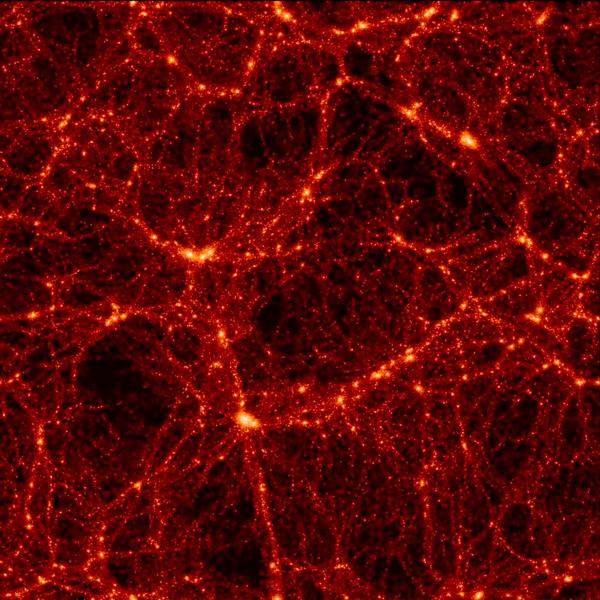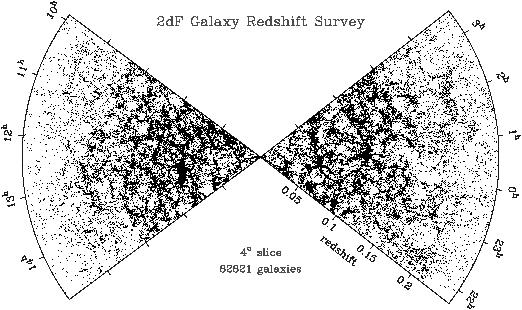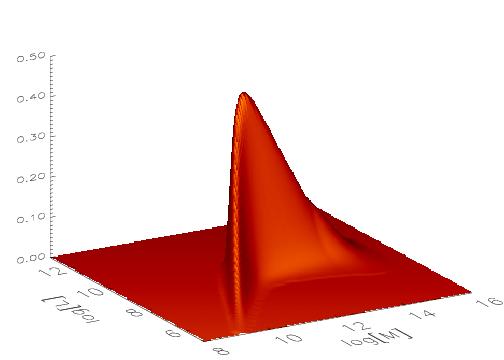Galaxy - Dark Matter Connection |
|
Scientists at the Max-Planck Institute for Astrophysics have developed a new technique to link the observed distribution of galaxies to the distribution of dark matter halos.
In the current cosmological framework the vast majority of matter is made up of some hitherto undetected particles. This cold dark matter matter, as it is generally called, is assumed to form dark matter halos inside of which galaxies form. Over the past decades scientist have developed a detailed understanding of the growth of such dark matter halos. In particular, accurate descriptions are nowadays available for the mass function of dark matter halos, which describes how many halos there are of given mass, as well as of their clustering properties (see Figure [1]). In recent years, large redshift surveys of galaxies have become available from which scientist have obtained similar statistical properties for the distributions of galaxies (see Figure [2]). Scientists at the Max-Planck Institute for Astrophysics have now developed a new technique to link the observed distribution of galaxies to the distribution of dark matter halos.

|
| Figure 1: The distribution of dark matter obtained from a large numerical simulation. Note how the dark matter is clustered into dark matter halos, which are connected by a large filamentary network. It is form simulations like these that astrophysicists have obtained a detailed understanding of the abundance and clustering of dark matter halos. This particular simulation is performed by the Virgo consortium, including scientists from the Max-Planck Institute for Astrophysics (see Jenkins et al. 1998, Astophysical Journal, 499, 20-40) |
This technique assigns, in a statistical manner, galaxies of given luminosities to halos of given mass. The function that describes how galaxies populate halos is called the conditional luminosity function. The goal of this technique is to, starting from the distribution of dark matter halos, obtain the conditional luminosity function that best reproduces the observed, statistical properties of the distribution of galaxies.

|
| Figure 2: The distribution of galaxies as obtained by the 2 degree Field Galaxy Redshift Survey (2dFGRS). Each galaxy is represented by a black dot. The observer on Earth is located at the center of this ``butter-fly'' shaped diagram. The radial distance from this center indicates the redshift of each galaxy, while the angle corresponds to the position on the sky. The challenge for astrophysicists is to link this distribution of galaxies to that of dark matter halos shown in Figure 1. |
The conditional luminosity function thus obtained contains valuable information. Since it describes how efficient a halo of given mass is in `producing' galaxies of certain luminosity, it can be used to infer useful constraints on the poorly understood physical processes associated with galaxy formation. In addition, since the statistical properties of dark matter halos are cosmology dependent, it can also provide important constraints on cosmological parameters. In fact, current data strongly suggests a Universal matter density that is close to the value favored by observations of high-redshift supernovae. Finally, the conditional luminosity function contains information about the distribution of light in the local universe. As an example, Figure [3] shows the probability function that a photon emitted by a galaxy originates from a galaxy with luminosity L that lives inside a halo of mass M. This function tells us that galaxies with a luminosity similar to that of the Milky Way living in halos of mass about 5 x 1012 solar masses are the most efficient producers of photons.

|
| Figure 3: The ``probability'' that a random photon in the local Universe is produced by a galaxy with luminosity L living inside a dark matter halo of mass M. This probability function is obtained from the conditional luminosity function that best fits the current data. |
In the coming years, new large redshift surveys, such as the Sloan Digital Sky Survey, in which the Max-Planck Institute for Astrophysics is involved, will dramatically improve both the quantity and quality of data on the distribution of galaxies. The conditional luminosity function technique described here will hopefully proof a useful tool in extracting important information regarding cosmology and galaxy formation from these new data.
| MPA-Home |